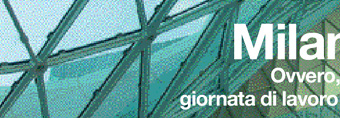




|
|

Premessa. Per principio non ci piace fare dello “sfascismo” e le nostre critiche muovono dalla speranza che le cose, dove possibile, siano migliorate in tempi ragionevoli.
È vero: nessuno “nasce imparato” e la strada della perfezione è lunga e tortuosa, ma aver reso agibile un quartiere fieristico, nuovo di pacca (Fiera Milano, polo Rho-Pero) senza garantire un livello minimo dei servizi, soprattutto in termini di mobilità, è qualcosa che lascia l’amaro in bocca.
Lo abbiamo sperimentato in occasione di Ipack-Ima, che si è chiusa il 18 febbraio con un bilancio, a nostro giudizio, complessivamente più che positivo, offuscato, ahimè, dalle tante, troppe inefficienze (non imputabili agli organizzatori della mostra) che il comprensorio ha dispensato a espositori e visitatori.
Va bene la vela di Fuksas, che nobilita la successione degli spazi coperti destinati all’esposizione, ma cotanta magnificenza avrebbe dovuto essere coniugata con un po’ più di attenzione agli aspetti pratici, che caratterizzano inevitabilmente il livello qualitativo di una struttura fieristica.
Per questa ragione, semplificando, molti partecipanti si sono in un certo senso sentiti ingannati, e quanto di buono hanno visto realizzato rispetto alla “vecchia” area del Portello, non ha rappresentato una contropartita all’altezza delle aspettative.
I conti non tornano: da una parte finalmente ampi spazi per il carico e scarico delle merci, in fase di allestimento e smontaggio, dall’altra, nuovamente, una viabilità ancora tutta da definire, che ha costretto a demenziali ed estenuanti code per entrare e uscire dai parcheggi: un’ora, un’ora e mezza di attesa, trascorse nella speranza di guadagnare la meta, non trovano giustificazione.
Non è andata poi tanto meglio a chi ha optato per la metropolitana: scarsa informazione sui biglietti “speciali” da utilizzare, poche biglietterie automatiche in funzione, numerosi tornelli chiusi, che rallentavano il flusso dei passeggeri, corse dei treni insufficienti, soprattutto nelle ore di punta.
Ma proseguiamo. Disporre di padiglioni monoplanari è stata un bella conquista, così come è stato funzionale il servizio di accoglienza dei visitatori, che poteva contare su ben quattro reception. Questo ha significato nessuna ressa o fila alle biglietterie - tanto che molti hanno ipotizzato una scarsa affluenza, smentita dalle cifre degli organizzatori che parlano di numeri in crescita rispetto al 2003 -, ma anche un’immediata percezione della planimetria complessiva della manifestazione, che ha favorito i contatti. Peccato, però, che il passaggio da un padiglione all’altro fosse in alcuni casi possibile, e in altri casi realizzabile in tempi accettabili, solo uscendo all’aperto. La mega struttura di ferro e vetro ha offerto sì un riparo dalla pioggia, ma non certo dal freddo, che a Milano in febbraio si fa sentire, eccome.
Un piccolo disagio, si potrebbe obiettare, ma non comprensibile se consideriamo che stiamo parlando del più nuovo e più grande quartiere fieristico europeo che, per prosperare, pensiamo debba operare al meglio non solo durante la bella stagione.
Lasciamo perdere le osservazioni di puntualizzanti addetti ai lavori, che facevano notare la “già” sporcizia della vela di vetro (la cui manutenzione, dobbiamo dedurre, si presenta piuttosto problematica), la scarsa attenzione posta nella rifinitura delle pavimentazioni, il malfunzionamento dei rubinetti dell’acqua nei servizi igienici (funzionali più che un’abluzione delle mani, a una doccia completa), la tardiva apertura degli ingressi riservati agli espositori provenienti dai parcheggi interni. Ma non possiamo tacere della rabbia di alcuni che, per mancanza di segnalazioni adeguate, non hanno saputo raggiungere le sale convegni, o di utenti che si sono visti recapitare l’impianto di registrazione richiesto per il proprio convegno a incontro terminato o che, ancora, hanno visto imbandire il prezioso catering concordato nel luogo e nel momento sbagliato.
«Sono ragazzi» come va di moda dire adesso, ma speriamo che crescano in fretta, se non vogliamo fare di un grande e ambizioso progetto di valore europeo il monumento mondiale all’improvvisazione.
|

|

Milano precox
Or rather, how to turn a working day at the fair into an adventure.
Foreword. As a principle we don’t like to do people down and our criticisms are made in the hopes that things, where possible, will be improved in reasonable time.
Truth to say nobody is born knowledgeable and the roads to perfection are long and tortuous, but having declared a brand new fair quarter (FieraMilano Rho-Pero pole) fit for use without guaranteeing a minimum level of services, aboveall in terms of mobility, is something that leaves you with a sour taste in your mouth.
This we experienced at Ipack-Ima, that closed February 18th with an overall balance, in our judgement, that was more than positive, shrouded alas by widespread inefficiency (not to be put down to the show organizers) that beset visitors and exhibitors in the general surrounds.
Fuksas’ sail is great, it adds finesse to the succession of covered spaces for the exhibition, but such magnificence ought to have been accompanied by a bit more attention to the practical aspects that inevitably characterise the qualitative level of a fair structure.
This is why, simplifying things, many of those taking part felt somewhat cheated, and thus all the fine work witnessed in having converted the “old” area of Portello was not enough to offset matters and fulfill their expectations.
There’s something wrong somewhere: on the one hand one at last has extensive space for loading and unloading merchandise, this in the setting up and taking down stages, on the other hand the road network still has to be worked out, currently the cause of an extenuating, crazy tailback on entering and leaving the parking lots: an hour or an hour-and-a-half long wait spent in the hope of attaining ones goal is in no way justified.
Things didn’t go that much better for those who opted for the Metro: scanty information on “special” tickets to be used, few ticket machines operating, a number of turnstiles closed that slowed down the flow of passengers, and not enough trains, aboveall during the rush hour. Having halls all on the same level was a fine achievement, the same going for the functionality of the visitor reception and check-in, that could count on as many as four desks.
This meant no crowds or queues at the ticket desks - to the point where many thought attendance was down, this being belied by the organizers’ figures that speak of an increase on 2003. Visitors also enjoyed an immediate perception of the overall plan of the show, that favored contacts.
A pity though that direct access from one hall to another was only possible in some cases, while in other cases this could only be achieved in reasonable time by going out into the open. The megastructure in iron and glass did indeed offer cover from the rain, but certainly not from the cold, that is very much to be felt in Milan in February.
A small problem one might object, but not to be comprehended if we consider we are speaking of the newest and largest European fair quarter that, in order to prosper, we feel should operate at its best the whole year round and not just when the fine weather sets in. Leaving to one side the observations of punctilious sector operators who drew attention to the “already” dirty glass sail (whose maintenance we have to deduce, should indeed be rather troublesome), the apparently somewhat hasty finishing of the flooring, the badly functioning taps in the rest rooms (that rather than offering an ablution for ones hands, give you a full shower) and the belated opening of the reserved entrances of the exhibitors accessing the complex from the interior carparks.
And we cannot fail to report the rage of some who, misled by poor signposting, were unable to reach the conference halls, or users who had their conference recording equipment handed to them after they had finished their talk, or on top of that, had the precious catering service set out at the wrong time in the wrong place.
«They’re young» as one says these days, but let’s hope they grow up quickly, if we don’t want to turn a great and ambitious project of European standing into a world monument to improvisation.
|